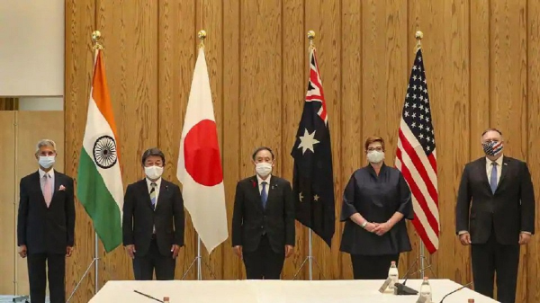The real anchor of the Indo-Pacific plan
Harsh V Pant | 24 October 2020
India’s position made others buy into the idea and incorporate it in their security outlooks
The challenge for the Indo-Pacific is getting more acute by the day. For all the efforts that China has made to ensure that the term Indo-Pacific gets a decent burial, it has failed miserably in ensuring such an outcome. From Australia, Japan, and India to the European Union (EU) and the Association of South East Asian Nations (Asean) member-states, the Indo-Pacific narrative is today widely accepted and reflected in foreign policy outlooks. The idea is a structural imperative now for all regional stakeholders and this has been made possible due to China’s behaviour. The only thing left now for Beijing is to mobilise regional states through fear-mongering, something it is adept at.
This was what China’s foreign minister, Wang Yi, tried to do during his trip last week to Cambodia, Malaysia, Laos, Thailand, and Singapore. Calling on Asian countries to remain vigilant over the United States (US)’ plans in the region, Wang described Washington’s Indo-Pacific strategy as a “security risk” for East Asia. Without any hint of irony, he argued that “what it (the US) pursues is to trumpet the old-fashioned Cold War mentality and start up confrontation among different groups and blocks, and stoke geopolitical competition”. For Southeast Asian nations, his message was that Beijing and Asean should work together to remove “external disruption” in the South China Sea.
Amid deteriorating Sino-US ties and Washington’s resolve to emerge as a credible partner in the region, Wang Yi was underscoring the choices facing the region. This was happening even as US Secretary of State Mike Pompeo’s visit to Tokyo for a meeting of the Quad had already raised the stakes for geopolitical competition in the region.
The very resurrection of this Quad grouping in 2017, involving the US, Japan, Australia and India is a function of China’s growing assertiveness and a deepening suspicion of Beijing’s intentions about its power. As regional stakeholders search for a new, more stable balance of power in the region, they are working with each other in ways that could not have been visualised even a few years ago. The new geometries dotting the regional landscape of the Indo-Pacific underscore this newfound conviction among the regional actors that old structures are just not effective enough anymore.
If the Quad meeting saw calls for deeper cooperation among major regional players, the various bilaterals and trilaterals embedded within it have been stronger in articulating the need for greater coordination among the stakeholders. There is a growing regional consensus that despite China’s attempts to discredit the idea, a free and open Indo-Pacific remains the only viable basis for engendering regional peace and stability. For the US, Pompeo’s visit during a high-stakes electoral contest in the US is an important signal to the region that the Indo-Pacific is now the central theatre in its geopolitical contestation with China. It also suggests that Washington will fight hard to retain its credibility. It was for this reason that Pompeo was categorical in underlining that “it is more critical now than ever that we collaborate to protect our people and partners from the CCP’s exploitation, corruption and coercion”.
The other regional powers might be more restrained in their remarks but their emphasis was clear — with Japan talking of advancing practical talks on issues such as infrastructure and cyber-security, Australia talking of human rights and India underscoring the need to respect territorial sovereignty. Bilateral ties are gathering pace with India-Japan, Australia-Japan and India-Australia reassessing the need for building cooperation on issues including maritime security, emerging strategic technologies, infrastructure and counterterrorism. The Malabar exercises and Australia’s participation must be seen within this context.
While it might be premature to talk of a “Quad plus” at this stage, major powers, at an individual level, and, in coordination with other like-minded countries, are serious about building coalitions.
Japan will be signing an agreement with Vietnam to allow it to export defence equipment and technology to the country during Japanese Prime Minister Yoshihide Suga’s visit to Vietnam this week. Japan will be seeking to strengthen security ties with Indonesia too.
But it is India that is the critical anchor in making the idea of Indo-Pacific a viable strategic geography. While Japan may have given the idea its original push, Australia may have given it intellectual ballast and Washington may have led the way in its operationalisation, it is New Delhi’s proactive foreign policy outlook that made it possible for others to buy into the concept and incorporate it in their security outlooks. No other country has done more than India in making the regional stakeholders believe that there is an alternative to just acquiescing to a China-led Asian order.
Whether it was publicly challenging President Xi Jinping’s vanity project, the Belt and Road Initiative, or standing up to China militarily at Doklam despite being the weaker State, whether it was giving a push to the idea of issue-based coalitions in the maritime sphere or rejecting the Regional Comprehensive Economic Partnership pact, much before other nations were talking about economic decoupling from China — New Delhi made it possible to envision an Indo-Pacific order which is not dominated by China.
As China galvanises its diplomacy to manage the negative externalities emerging out of this Indo-Pacific vision, which, despite Beijing’s best efforts, is going from strength to strength, the challenge for India is to sustain the momentum of showcasing the Indo-Pacific vision and its operational realities.
Harsh V Pant is professor, King’s College, London, and director of studies, Observer Research Foundation, New Delhi.
This article was originally published on Hindustan Times.
Views in this article are author’s own and do not necessarily reflect CGS policy.
